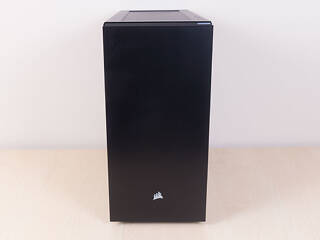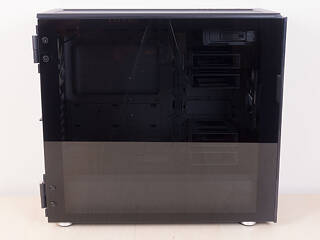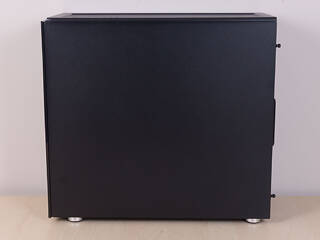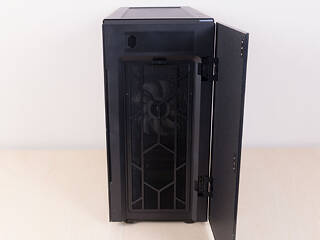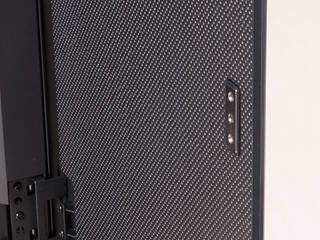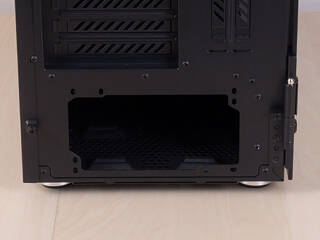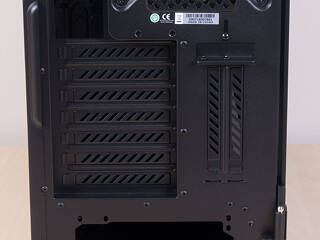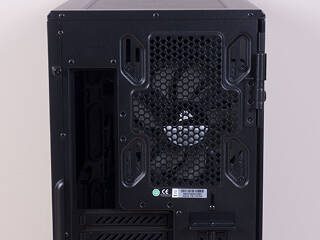 5
5
Corsair Carbide 678C Review
A Closer Look - Inside »A Closer Look - Outside
Out of the box, the glass panel is protected by a plastic layer, and the aforementioned solid cover comes taped to the top of the enclosure. As the Carbide 678C is meant to be a silent enclosure, its overall design is understated and clean, with a door covering the front of the chassis.
Even though the front door is made out of plastic, it feels quite sturdy. Corsair kept it pretty smooth and has placed their branding on the bottom part of the panel. In the rear, everything looks pretty standard as far as the layout is concerned, but here, it becomes apparent that the Carbide 678C is slightly wider than some other mid-tower cases out there.
The main side panel is made out of glass and swings open for easy access. You may also take it off its hinges to put it somewhere save before commencing with system assembly, for example. On the opposite side, you will find nothing but a solid metal panel that is held in place by two thumb screws.
The door of the chassis swings open to the right and reveals a large dust filter behind which Corsair has placed a retail-grade 140 mm intake unit. You will find another dust filter lining the entire underside of the chassis; it may easily be pulled out through the front.
There is also a single 5.25" drive bay, which is quite the unusual sight these days, and it features a plastic pull-out tab for easy removal. Corsair has lined the interior of the door with a thin layer of sound-insulating material. Several metal pieces here allow for the built-in magnets to hold the door shut without the need for an additional locking mechanism.
In the rear, the bottom PSU bay comes with two sets of mounting holes, and as you can see, there is plenty of room next to it for cable management. Above that are the 7+2 expansion slots and another retail-grade 140 mm fan—this one is set to blow air out the back of the chassis.
Out of the box, the Corsair Carbide 678C comes with a magnetically attached metal mesh cover on top. Next to it, you will find a fairly large power LED, two USB 3.0, a single USB 3.1 Gen2 Type-C, and the usual audio I/O.
Mar 10th, 2025 13:06 EDT
change timezone
Latest GPU Drivers
New Forum Posts
- It's happening again, melting 12v high pwr connectors (1019)
- RX 9070 availability (162)
- newegg ATX 3.1 PSU on Clearance and Free Fan (2)
- What's your latest tech purchase? (23269)
- Gaming PC instabiliity (15)
- Samsung 9100 PRO is on preorder (0)
- I'm looking for a good tool to make the 3D scanning of my mini-pc using the photogrammetry and my Kinect 2. (45)
- 2022-X58/1366 PIN Motherboards NVME M.2 SSD BIOS MOD Collection (903)
- Surface laptop 5 TPL Speed Shift ignored? (1)
- Looking for silent 9070 (XT) (9)
Popular Reviews
- Sapphire Radeon RX 9070 XT Nitro+ Review - Beating NVIDIA
- XFX Radeon RX 9070 XT Mercury OC Magnetic Air Review
- ASUS Radeon RX 9070 TUF OC Review
- MSI MAG B850 Tomahawk Max Wi-Fi Review
- NVIDIA GeForce RTX 5080 Founders Edition Review
- NVIDIA GeForce RTX 5070 Founders Edition Review
- Corsair Vengeance RGB CUDIMM DDR5-8800 48 GB CL42 Review
- AMD Ryzen 7 9800X3D Review - The Best Gaming Processor
- ASUS GeForce RTX 5070 Ti TUF OC Review
- MSI GeForce RTX 5070 Ti Gaming Trio OC+ Review
Controversial News Posts
- NVIDIA GeForce RTX 50 Cards Spotted with Missing ROPs, NVIDIA Confirms the Issue, Multiple Vendors Affected (513)
- AMD Plans Aggressive Price Competition with Radeon RX 9000 Series (277)
- AMD Radeon RX 9070 and 9070 XT Listed On Amazon - One Buyer Snags a Unit (261)
- AMD RDNA 4 and Radeon RX 9070 Series Unveiled: $549 & $599 (260)
- AMD Mentions Sub-$700 Pricing for Radeon RX 9070 GPU Series, Looks Like NV Minus $50 Again (248)
- NVIDIA Investigates GeForce RTX 50 Series "Blackwell" Black Screen and BSOD Issues (244)
- AMD Radeon RX 9070 and 9070 XT Official Performance Metrics Leaked, +42% 4K Performance Over Radeon RX 7900 GRE (195)
- AMD Radeon RX 9070-series Pricing Leaks Courtesy of MicroCenter (158)

